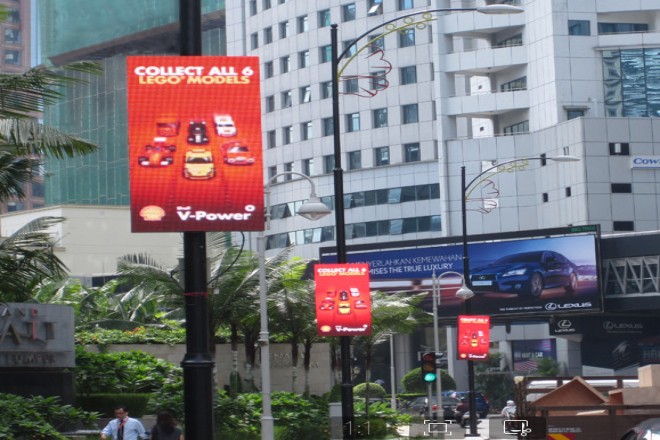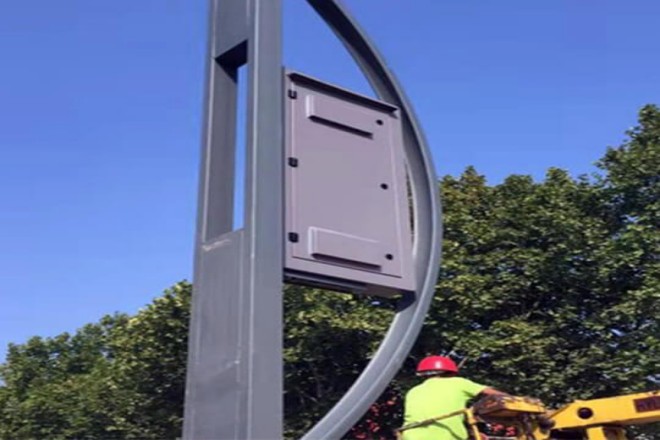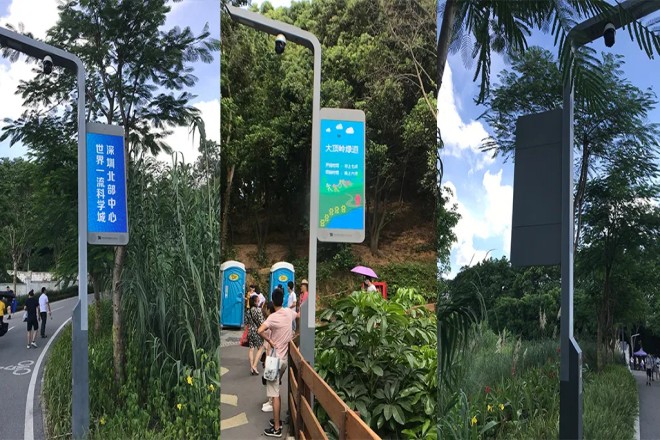介绍
1、灯杆LED显示屏的基本防护能力有哪些?
当我们走在城市的大街小巷时,总能看到那些闪闪发光的LED灯杆显示屏。它们就像城市的眼睛,传递着各种各样的信息。但你知道吗?这些LED灯杆显示屏的设计考虑到了各种户外环境挑战,尤其是雨水和风的影响。
1).防雨设计:
灯杆屏就像是孩子穿了一件雨衣,采用密封结构,就像雨衣的拉链和纽扣一样,紧紧包裹着内部的电子元器件,防止雨水渗入。
特殊的防水材料和技术,如防水胶圈、防水涂层等,就好比雨衣上的防水面料,可以进一步提升显示屏的防水性能。
因此,即使在雨天或潮湿的环境中,显示屏也能正常工作并为我们提供清晰的信息。
2).抗风结构:
如果说显示屏就像一张纸,一阵强风就可能把它吹走,但灯杆屏就不同了,它的安装设计是经过深思熟虑的,设计师会考虑风荷载因素,就像建筑师在设计高层建筑时会考虑风力一样。
他们将通过合理的结构设计和材料选择,保证显示屏能在正常天气条件下安装到灯杆上。
此外,他们还会采用不锈钢、铝合金等高强度材料,这些材料就像是显示器的铠甲,不仅提高了显示器的抗风能力,还增强了其整体结构强度。
因此即使面对复杂多变的户外环境,显示屏也能屹立不倒。
总的来说,灯杆屏的基本防护能力就像一道坚固的屏障,保护内部电子元器件不受外界环境的影响。
2. 暴风雨对LED灯杆屏的特殊挑战

暴雨这种自然灾害无疑对城市基础设施是一次不小的考验,而对于灯杆屏来说,这种极端天气不仅是对其物理结构的严峻挑战,更是对其功能稳定性的极大考验。
1). 物理结构的极限挑战
当暴风雨来袭时,强风和暴雨的威力往往超乎人们的想象,而作为支撑显示屏“主干”的灯杆,可能无法抵御狂风的侵袭,出现弯曲甚至折断的现象。
而显示屏本身,这个由精密电子元器件构成的“脸面”,在暴雨的冲刷、强风的冲击下,也可能会出现碎裂的情况。
这些物理损坏不仅会影响显示屏的外观和正常使用,还可能对其背后的信息传播系统造成无法估量的损失。
2). 对功能稳定性的潜在威胁
除了物理损坏外,严重的风暴还可能对灯杆LED显示屏的功能稳定性造成严重影响。
大雨带来的大量水气和潮气可能渗入显示屏内部,造成短路或电子元器件损坏;强风可能引起显示屏内部震动,进一步加剧损坏。
一旦显示屏的功能稳定性受到影响,其传递信息的能力就会大大降低,甚至会导致信息的误传、遗漏,给城市管理和市民生活带来诸多不便。
面对这些挑战,我们需要采取更加全面、有效的措施来保护灯杆LED显示屏。
从加强灯杆和显示屏的结构设计,提高其抗风防水性能,到定期对显示屏进行维护和检查,确保其在极端天气条件下能保持稳定的工作状态,每一个环节都至关重要。
只有这样,才能保证灯杆LED显示屏在严酷风暴的洗礼下,依然能够屹立不倒、熠熠生辉,为信息的传播、美化城市贡献力量。
3. 暴雨天气如何保护灯杆LED显示屏
暴雨就像是大自然的一次激烈考验,对城市灯杆LED显示屏提出了严峻的挑战。为了保证这些显示屏在极端天气下依然能够稳定运行,需要采取一系列精心策划的防护策略。
1).日常防护:
日常维护是保证显示屏安全运行的基石,需要定期检查灯杆及显示屏的稳固性,及时发现、加固安全隐患,确保其在风雨中依然稳固。
同时,清理排水系统也至关重要,确保雨水能快速排出,避免积水损坏显示屏。这一步看似简单,却能有效降低暴雨天气下显示屏受损的风险。
2). 应急准备:
面对暴雨天气,制定详细的应急预案至关重要,在暴雨来临前关闭显示屏,降低电路短路、元器件损坏的风险。
同时组建专业的应急抢修队伍,准备充足的抢修物资,确保灾难发生后能迅速响应,恢复显示屏的正常运行。这种提前谋划、快速行动的态度,在关键时刻能起到减少损失的关键作用。
3).科技赋能:
技术创新与升级是提高显示屏抗风防水性能的关键。
积极探索和应用高强度、耐腐蚀复合材料、先进防水涂料等新材料、新技术,提升显示屏的耐用性。
此外,加入智能监控和预警系统也是不可或缺的一部分。
通过实时监测显示屏的运行状态和外界环境的变化,可以提前发现潜在的安全隐患,并采取相应的预防措施,为显示屏的安全运行提供有力的保障。
综上所述,灯杆屏应对暴雨灾害的防护策略,需要综合考虑日常维护、应急准备、科技赋能等多个方面。
只有全面加强这些工作,才能保证显示屏在极端天气下依然能够稳定运行,为信息传播和美化城市贡献力量。
4、灯杆LED显示屏遭遇暴雨天气如何“急救”

当灯杆LED显示屏遇到暴雨天气时,及时“急救”至关重要。以下是一套详细的急救步骤:
1). 初步治疗
断电保护: 首先要立即切断显示屏的电源,防止发生短路,造成进一步的损坏,这是急救步骤中的首要任务,可以最大程度的保护显示屏内部的电子元器件不受损坏。
表面清洁: 使用干净、不起毛的吸水毛巾或抹布轻轻擦拭显示屏表面,清除残留的水分和杂质。注意动作要轻柔,避免划伤或损坏显示屏表面。
2). 内部除湿
用风扇吹干: 确保显示器断电后,尽快使用风扇或其他合适工具吹干显示器内部的湿气,注意使用冷风,避免热风对显示器内部元器件造成热损坏。
空调除湿:如果条件允许,可以将显示器周围的空调设置为除湿模式,并确保空调出风口不要对着显示器,避免凝露水对显示器造成二次损坏。
除湿机和风扇:在显示器前方放置除湿机和风扇,可以加速显示器内部的除湿过程。除湿机可以有效降低空气中的湿度,而风扇可以加速空气流通,帮助显示器更快干燥。
3). 通电老化及测试
- 分阶段上电老化:
显示屏内部湿气基本排除后,需要进行通电老化处理,可通过逐步增加 亮度 并分阶段进行通电老化。
例如,可以先将亮度调至10%,通电老化8-12小时;再逐步将亮度调至30%、60%、80%、100%,每阶段通电老化。此步骤有助于恢复显示屏内部电子元件的性能,减少因受潮而导致的故障。
- 综合评估和测试:
完成开机老化后,需要对显示屏进行全面评估,检查是否存在死灯、亮度不均等异常情况,同时还需要进行功能测试,确保显示屏能正常显示信息。
4). 专业保养及涂装处理
专业维护:
若显示屏在大雨中受损较为严重或者经过初步处理、通电老化后仍然出现故障,则需要联系专业维修人员进行维修。
他们可以对显示器进行全面的检查和修复,以确保其能够恢复正常运行。
涂层处理:
为了增强显示器的防水性能,可以考虑在显示器表面镀膜,形成一层保护膜,有效防止湿气、杂质对显示器的侵蚀。
5).预防措施及后续维护
加强日常保养: 定期保养和检查显示屏,确保其处于良好的工作状态。这包括清洁排水系统、检查杆的稳定性等。
制定应急计划:在暴雨等极端天气到来前,提前制定应急预案,准备好相应的抢修物资和队伍,能够在灾害发生时快速应对,减少损失。
提高防护等级: 考虑提升显示屏的防护等级,比如采用更高标准的防水材料和技术,这样可以从根本上提高显示屏的抗风防水性能,减少极端天气带来的损害。
结论
综上所述,面对强风暴雨,灯杆LED显示屏需要采取全面、细致的防护措施。
通过加强维护、制定预案、技术创新、协同管理,有效降低极端天气影响,保障显示屏稳定运行,为市民提供安全便捷的信息服务。
最后,如果你想了解更多关于LED显示屏的信息, 请与我们联系。

